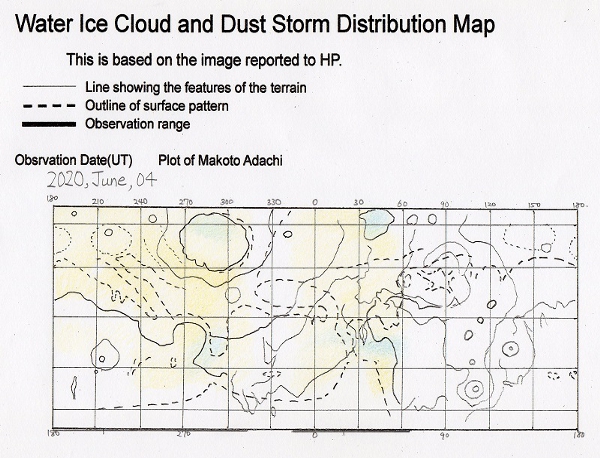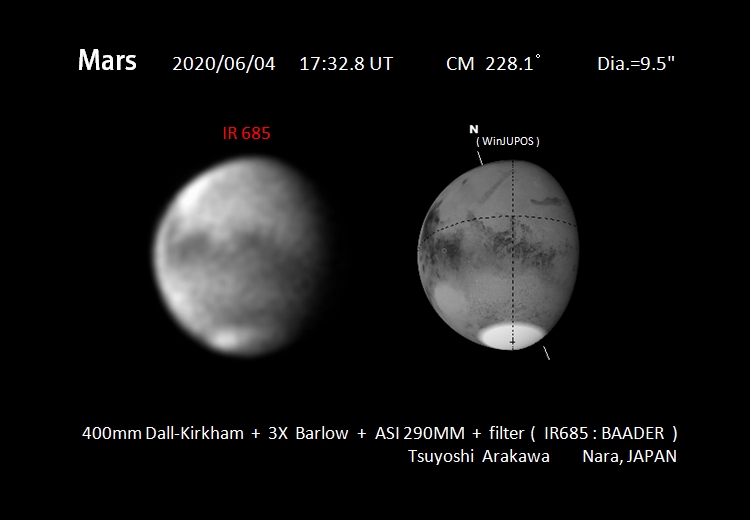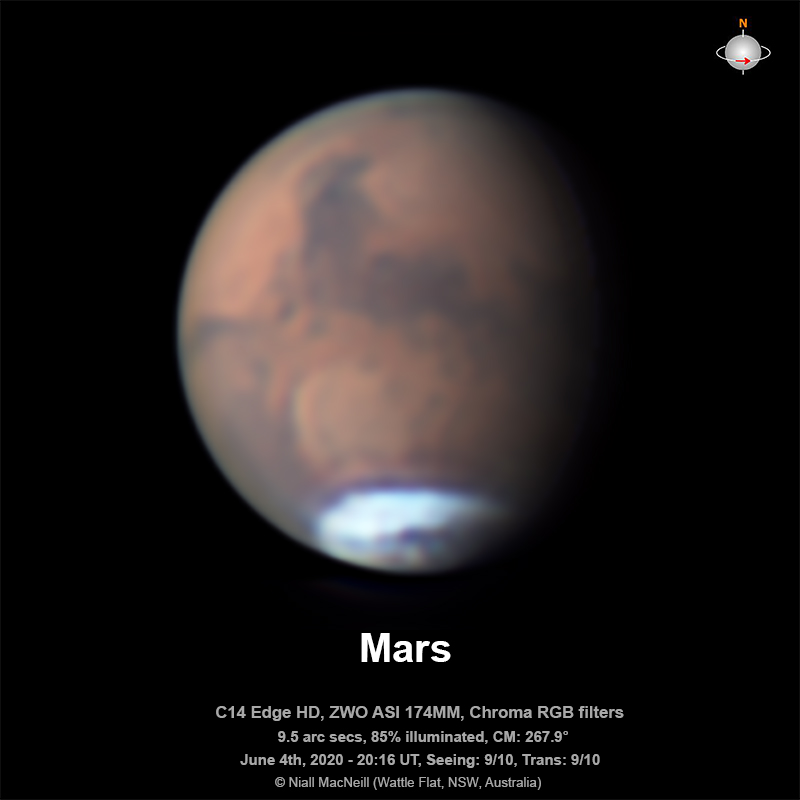火星 ALPO-Japan Latest

Mars Image 2020/06/04(UT)
荒川 毅,大杉忠夫
Clyde Foster,Niall MacNeill,Mark Lonsdale,Milika-Nicholas
C.Foster,T.Arakawa,N.MacNeill,T.Ohsugi,M.Lonsdale,Milika-Nicholas
解説(安達)/ Comment by Makoto Adachi
Clyde Foster氏の画像はオキシア(Oxia palus;8W,+12)付近の様子をよく記録している。この部分は今シーズンの模様の変化をよく記録している。
SPCは地肌が直誠意的に見え、割れ目となって見えていることが分かる。カラーになっているため、割れ目という感じには記録されていない。
Mark Lonsdale氏の画像は、大気の様子をよく再現できている。南半球と北半球のベールは色が違っている。この様子は肉眼観測でもよくわかる、現在の特徴だ。
The image of Mr. Clyde Foster often records the situation around Oxia palus (8W, +12). This part is a good record of changes in the season.
It can be seen that the background of SPC appears to be honest and appears as cracks. Since it is in color, it is not recorded as a crack.
The image of Mr. Mark Lonsdale reproduces the atmosphere well. The veils of the southern and northern hemispheres have different colors.
This is a current feature that can be seen with the visual observation.
(by 6 observations; reported by Makoto Adachi)
 -------------------------------------------------------------------------------------
-------------------------------------------------------------------------------------
At least at the start of my session,I had some reasonable seeing this morning and I was able to capture this image set of Mars,
before the seeing dramatically degenerated for my Jupiter session.
S Meridiani is at centre left with Niliacus Lacus and M Acidalium at lower centre.
M Erythraeum extends across the upper centre with Argyre at upper centre.
Some light features may highlight some of the Valles Marineris complex just right of centre.
This image again seems to indicate that there is some dust across the SPC although I do not know if this is atmospheric or deposited.
My feeling is that it may be deposited. Looking at mine,and others recent images,
I also have the perception(I could be wrong....) that there may be dust haze across the planet.
Possibly some residual from the dust activity we have seen over the last few months?
 [Clyde Foster:Centurion,South Africa]
[Clyde Foster:Centurion,South Africa]
雲をとおして火星がぼんやりと見えていたので撮影してはみたものの、IR画像以外は、すべてボツになりました。
 ≪奈良県奈良市 荒川 毅≫[Tsuyoshi Arakawa:Nara Japan]
≪奈良県奈良市 荒川 毅≫[Tsuyoshi Arakawa:Nara Japan]
Mars has now grown to 9.5 arc secs in apparent diameter and getting up towards half the size it will attain at closest approach in October.
This is an iconic Mars view with the albedo feature Syrtis Major jutting up like a promontory into the vast ocean of red dust to the north.
The circular light coloured feature to the south is the Hellas Basin,which is an enormous impact crater,2300kms in diameter and 7kms deep.
There is an amazing herringbone bank of rusty red dust clouds right across the region.
The South Polar Cap is now showing significant wear and tear as it shrinks and its solid white CO2 (dry ice) is sublimating
(solid straight to gas) in the relative warmth of the southern summer.
 [Niall MacNeill : Wattle Flat,NSW,Australia]
[Niall MacNeill : Wattle Flat,NSW,Australia]
 ≪石川県小松市 大杉忠夫≫[Tadao Ohsugi:Komatsu city Ishikawa pre,Japan]
≪石川県小松市 大杉忠夫≫[Tadao Ohsugi:Komatsu city Ishikawa pre,Japan]
 [Mark Lonsdale : [Canberra,Australia]
[Mark Lonsdale : [Canberra,Australia]
A Mars image from 4th June, this is actually the result of combining 2 rgb captures where the same g & b captures were used with 2 different red filter captures that were then WinJUPOS' integrated...ie, not an r-rgb!
The seeing was better than that of earlier that morning & the resulting image shows a lot of detail for a sub-10 arc-second image: in the image are the individual channels shown at capture scale as well as the best frame as selected by AS!3,
demonstrating pretty decent seeing at this early stage in the apparition. :)
 [Milika-Nicholas:Adelaide,South Australia]
[Milika-Nicholas:Adelaide,South Australia]


-------------------------------------------------------------------------------------
[Clyde Foster:Centurion,South Africa]
≪奈良県奈良市 荒川 毅≫[Tsuyoshi Arakawa:Nara Japan]
[Niall MacNeill : Wattle Flat,NSW,Australia]
≪石川県小松市 大杉忠夫≫[Tadao Ohsugi:Komatsu city Ishikawa pre,Japan]
[Mark Lonsdale : [Canberra,Australia]
[Milika-Nicholas:Adelaide,South Australia]
 ALPO-Japan Latest
ALPO-Japan Latest

 Mars Section
Mars Section